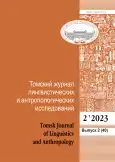Рассматривается архаический языковой пласт тунгусо-маньчжурских народов, связанный с охотой. Выявляется лексика языка древней тунгусской общности, возникшая в эпоху становления культуры пеших охотников-прототунгусов эпохи неолита. Теоретической основой исследования послужили труды специалистов тунгусоведения, посвященные языку тунгусо-маньчжурских народов. Методология исследования основывается на междисциплинарном подходе, в рамках которого для решения лингвистической проблемы привлекаются результаты исследований смежных научных дисциплин, в числе которых работы, посвященные фольклору, этнографии, истории и археологии. Соответственно избранной методике исследуемый лексический пласт рассматривается через призму традиций этнического мировоззрения и устного народного творчества. Материалом исследования являются изданные словари, сборники устного народного творчества тунгусо-маньчжурских народов и полевые материалы автора. Результаты анализа архаического языкового пласта, связанного с охотой, сюжеты и мотивы фольклора, базовые мировоззренческие образы и социальные традиции тунгусо-маньчжурских народов свидетельствуют о его формировании в ландшафте горной тайги с наступлением голоцена в процессе развития кочевой культуры пеших охотников. В результате исследования автор приходит к выводу об архаичности традиций охоты, формировавшихся в эпоху древней тунгусской общности. Важнейшие архаические культурные традиции тунгусо-маньчжурских народов находят отражение в названиях орудий труда, важнейших объектов охотничьего промысла и базовых концептах, связанных с охотой. К древнетунгусскому лексическому пласту относятся слова: hurka – «петля, силок», bər – «лук [простого типа]», n`ur – «стрела», kiŋnə – «лыжи-голицы», huksi – «лыжи, подбитые камусом», omor – «лодка-берестянка», niki – «утка», toki – «лось», uǯa – «след», bu(l)ta, bota – «охота», bujun – «копытный зверь». В мировоззренческих традициях тунгусов «охота» как концепт исторически визуализируется в значениях «добыча», «дар», «дарение».
 9-20
9-20


 21-36
21-36


 37-48
37-48


 49-64
49-64


 65-78
65-78


 79-89
79-89


 90-99
90-99


 100-113
100-113


 114-128
114-128


 129-141
129-141


 142-150
142-150


 151-163
151-163


 164-168
164-168












